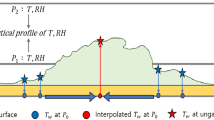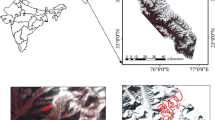Abstract
We estimated the dust aerosol influx into the snow cover in the region of Nizhnevartovsk. The average content of solid insoluble particles in snowmelt waters for conventionally background area is 12.0 mg/L, four times larger than for the reference uncontaminated territories. The high local background is typical for the Middle Ob River area and is due to the effect of remote oil production plants. Under urban conditions, the aerosol dust influx increases by a factor of 7.5 relative to conventionally background area. The dust particle influx leads an intense alkalization of snow cover. Results obtained during field tests are compared with spectral properties of snow. Landsat-8 (OLI sensor) data are used to calculate snow indices (normalized difference index, normalized index, and contamination index), which agree with ground-based observations and can be used to estimate the technogenic contamination level. The normalized snow index is optimal to estimate the amount of dust sediments, and snow contamination index is optimal to estimate acid–base (pH) conditions.

Similar content being viewed by others

REFERENCES
V. R. Alekseev, “Snow cover as an indicator of cumulative soil pollution,” Led Sneg 121 (1), 127–140 (2013).
N. S. Kasimov, Ecogeochemistry of Urban Landscapes (Moscow State University, Moscow, 1995) [in Russian].
N. S. Kasimov, N. E. Kosheleva, D. V. Vlasov, and E. V. Terskaya, “Geochemistry of snow cover within the eastern district of Moscow,” Vestn. Mosk. Univ. Ser. 5. Geografiya, No. 4, 14–24 (2012).
V. G. Bondur, “Aerospace monitoring techniques for petroleum districts and oil and gas industry facilities,” Issled. Zemli Kosmosa, No. 6, 3–17 (2010).
V. F. Usachev, Temporal Methodical Recommendations on the Use of Satellite Data: Estimation of Snow Cover Pollution near Industrial Centers (Gidrometeoizdat, Leningrad, 1984) [inRussian].
V. G. Prokacheva and V. F. Usachev, Snow Cover within Umland (Gidrometeoizdat, Leningrad, 1989) [in Russian].
J. Dozier, S. R. Schneider, and Jr. D. F. McGinnis, “Effect of grain size and snowpack water equivalence on visible and near-infrared satellite observations of snow,” Water Resour. Res. 17, 1213–1221 (1981).
J. Dozier, “Snow reflectance from Landsat-4 Thematic Mapper,” IEEE Trans. Geosci. Remote Sens, No. 3, 323–328 (1984).
K. Higuchi and A. Nagoshi, “Effect of particulate matter in surface snow layers on the albedo of perennial snow patches,” IAHS-AISH Publ. 118, 95–97 (1977).
S. G. Warren, “Impurities in snow: Effects on albedo and snowmelt,” Ann. Glaciol. 5, 177–179 (1984).
D. K. Hall, G. A. Riggs, and V. V. Salomonson, “Development of methods for mapping global snow cover using moderate resolution imaging spectroradiometer data,” Remote Sens. Environ. 54, 127–140 (1995).
V. G. Prokacheva and V. F. Usachev, Soil Pollution in Rural and Urban Areas and in River Runoffs. Ural Federal District (Nedra, St. Petersburg, 2007) [in Russian].
A. A. Lagutin, I. A. Sutorikhin, V. V. Sinitsin, A. P. Zhukov, and I. A. Shmakov, “The monitoring of the large industrial centers of the south of West Siberia, using the MODIS and field observation data,” Opt. Atmos. Okeana 24 (1), 60–66 (2011).
A. I. Sukhinin, M. V. Vorob’eva, and E. A. Okhotkina, “Space-based MODIS radiometer monitoring of snow cover in Siberia,” Vestn. Reshetnev Sib. Gos. Aerokosmich. Univ. 37 (4), 90–96 (2011).
V. F. Raputa and T. V. Yaroslavtseva, “Estimation of long-term pollution of urban air from data of ground-based and satellite monitoring of snow cover,” in Abstracts of the XV All-Russian Open Conference “Modern Problems of Remote Earth Sounding from Space” (2017), p. 109.
V. F. Raputa and T. V. Yaroslavtseva, “Ground-based and satellite monitoring of urban snow cover pollution and estimation of the population health,” Interekspo GEO-Sibir 4 (1), 32–36 (2017).
M. I. Vasilevich, V. M. Shchanov, and R. S. Vasilevich, “Application of satellite methods to assess snow cover pollution around industrial enterprises in the tundra zone,” Sovr. Problemy Distantsionnogo Zondirovaniya Zemli Kosmosa 12 (2), 50–60 (2015).
E. Snyder-Conn, J. R. Gabriano, G. L. Hoffman, and A. Oelkers, “Soluble trace elements and total mercury in Arctic Alaskan snow,” Acrtic 50 (3), 201–215 (1997).
C. Gueguen, C. W. Cussb, and S. Cho, “Snowpack deposition of trace elements in the Athabasca Oil Sands region, Canada,” Chemosphere 153, 447–454 (2016).
D. V. Moskovchenko and A. G. Babushkin, “Peculiarities of formation of chemical composition of snow waters (on example of Khanty-Mansi autonomous district),” Kriosfera Zemli 16 (1), 71–81 (2012).
R. Yu. Pozhitkov, D. V. Moskovchenko, and A. A. Kudryavtsev, “Geochemistry of snow cover in Nizhnevartovsk,” Vestn. Tyumen. Gos. Univ. Ekologiya Prirodopol’zovanie 4 (1), 6–24 (2018).
Yu. M. Polishchuk and O. S. Tokareva, “Geosimulation modeling zones of atmosphere pollution as a result of gas burning at oil fields,” Informatsionnye Sistemy Tekhnologii, No. 2, 39–46 (2010).
V. V. Antonovich, B. D. Belan, V. I. Vaver, V. K. Kovalevskii, T. M. Rasskazchikova, A. V. Sibirko, and G. N. Tolmachev, “Estimation of the air quality of petroleum producing areas,” in Study of Environmental and Geographic Issues of Nature Management for Ensuring Organization and Sustainability of Russian Petroleum Producing Regions: Theory, Techniques, and Practice (NGPI, KhMRO RANS, IAO SB RAS, Nizhnevartovsk, 2000), p. 216–220 [in Russian].
Environmental Geochemistry, Ed. by Yu.E. Saet, B.A. Revich, and E.P. Yanin (Nedra, Moscow, 1990) [in Russian].
Air Pollution Control Guide. RD 52.04.186, No. 2932-83 (Goskomgidromet, Moscow, 1991) [in Russian].
https://rp5.ru/. Cited July 7, 2010.
A. Saito and T. Yamazaki, “Characteristics of spectral reflectances for vegetation ground surfaces with snow cover: Vegetation indices and snow indices,” J. Jap. Soc. Hydrol. Water Resour. 12, 28–38 (1999).
S. G. Warren and W. J. Wiscombe, “A model for the spectral albedo of snow—II: Snow containing atmospheric aerosols,” J. Atmos. Sci. 37, 2734–2745 (1980).
H. S. Negi, A. V. Kulkarni, and B. S. Semwal, “Study of contaminated and mixed objects snow reflectance in Indian Himalaya using spectroradiometer,” Int. J. Remote Sens. 30 (2), 315–325 (2009).
H. S. Negi, S. K. Singh, A. V. Kulkarni, and B. S. Semwal, “Field-based spectral reflectance measurements of seasonal snow cover in the Indian Himalaya,” Int. J. Remote Sens. 31 (9), 2393–2417 (2010).
N. S. Kasimov, Russian Regions and Towns: Integral Estimation of the Environmental State (IP M.V. Filimonov, Moscow, 2014) [in Russian].
N. V. Krutskikh and I. Yu. Kravchenko, “The use of LANDSAT satellite images for geoecological monitoring of urbanized areas,” Sovremennye Problemy Distantsionnogo Zondirovaniya Zemli Kosmosa 15 (2), 159–168 (2018).
V. P. Shevchenko, A. P. Lisitsyn, R. Shtein, N. V. Goryunova, A. A. Klyuvitkin, M. D. Kravchishina, M. Kriews, A. N. Novigatskii, V. T. Sokolov, A. S. Filippov, and Kh. Haas, “Distribution and composition of insoluble particles in the Arctic snow,” Problemy Arktiki Antarktiki 75 (1), 106–118 (2007).
V. P. Shevchenko, S. N. Vorob’ev, S. N, Kirpotin, I. V. Kritskov, R. M. Manasypov, O. S. Pokrovskii, and N. V. Politova, “Investigations of insoluble particles in the snow cover of the Western Siberia from Tomsk to the Ob estuary,” Opt. Atmos. Okeana 28 (6), 499–504 (2015).
E. G. Yazikov, A. V. Talovskaya, and L. V. Zhornyak, Estimation of the Ecological and Geochemical Conditions on the Tomsk territory from the study of on dust aerosols and soils (Tomsk Politekhnical Univ., Tomsk, 2010) [in Russian].
V. V. Litau, A. V. Talovskaya, A. D. Lonchakova, M. I. Tret’yakova, and K. Yu. Mikhailova, “The level of dust pollution of air in Omsk according to snow-geochemical survey data,” in Proc. of the Conference of Young Scientists “Urgent Geochemical Problems” (Publishing House of Sochava Institute of Geography, SB RAS, Irkutsk, 2013), p. 82–84 [in Russian].
Yu. V. Ermolov and N. B. Smolentsev, “Winter background aerosol deposition in the south-eastern part of Western Siberia,” Opt. Atmos. Okeana 33 (1), 75–81 (2020).
A. V. Talovskaya, “Geochemical characteristic of dust atmospheric precipitations on the Tomsk area,” Opt. Atmos. Okeana 23 (6), 519–524 (2010).
A. I. Syso, V. S. Artamonova, M. Yu. Sidorova, Yu. V. Ermolov, and V. S. Cherevko, “Pollution of the atmosphere, snow and soil cover of Novosibirsk,” Atmos. Ocean. Opt. 18 (8), 593–599 (2005).
A. V. Talovskaya, E. A. Filimonenko, and E. G. Yazikov, “Dynamics of the elemental composition of the snow cover in the north-eastern zone of influence of Tomsk–Seversk industrial agglomeration,” Opt. Atmos. Okeana 27 (6), 491–495 (2014).
A. A. Onuchin, T. A. Burenina, O. N. Zubareva, O. V. Trefilova, and I. V. Danilova, “Pollution of snow cover in the impact zone of enterprises in Norilsk industrial area,” Contemp. Probl. Ecol. 7 (6), 714–722 (2014).
M. S. Kholodova, M. V. Pastukhov, and V. I. Poletaeva, “Features of mineral and material composition of snow cover solid-phase precipitations in the town of Svirsk area,” Izv. Sib. Otdeleniya RAEN. Geologiya, Poiski Razvedka Rudnykh Mestorozhdenii, No. 4, 109–118 (2016).
https://nizhnevartovsk.itpgrad.ru/spatialdevelopment. Cited April 30, 2010.
A. V. Kulkarni, J. Srinivasulu, and S. S. Manjul, “Field based spectral reflectance studies to develop NDSI method for snow cover monitoring,” J. Indian. Soc. Remote Sens 30, 73–80 (2002).
Funding
This work was carried out under the support of the Russian Foundation for Basic Research (grant no. 19-05-50062\19) and in the framework of fundamental research of the Siberian Branch, Russian Academy of Sciences (project no. AAAA-A17-117050400146-1).
Author information
Authors and Affiliations
Corresponding author
Ethics declarations
The authors declare that they have no conflicts of interest.
Additional information
Translated by O. Bazhenov
Rights and permissions
About this article
Cite this article
Pozhitkov, R.Y., Tigeev, A.A. & Moskovchenko, D.V. Estimation of Dust Depositions in Snow Cover Using Earth’s Remote Sensing Data: Example of Nizhnevartovsk. Atmos Ocean Opt 34, 19–25 (2021). https://doi.org/10.1134/S1024856021010103
Received:
Revised:
Accepted:
Published:
Issue Date:
DOI: https://doi.org/10.1134/S1024856021010103



